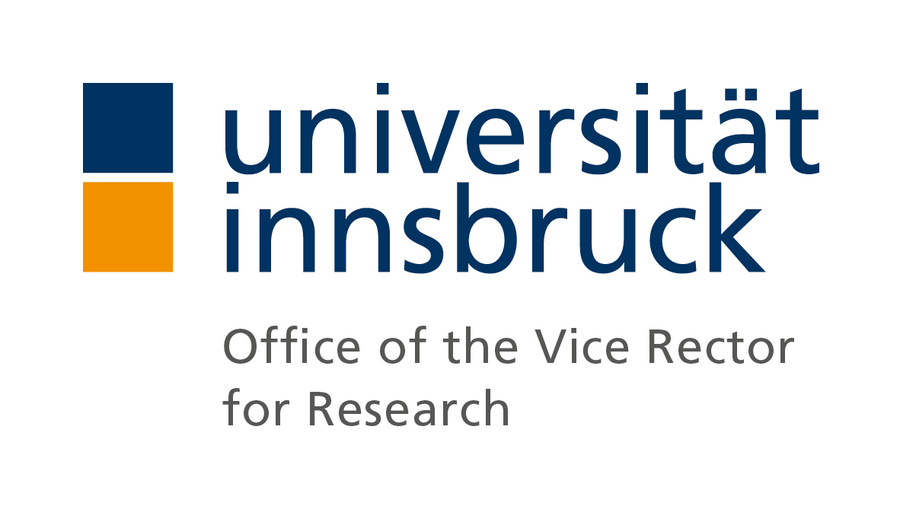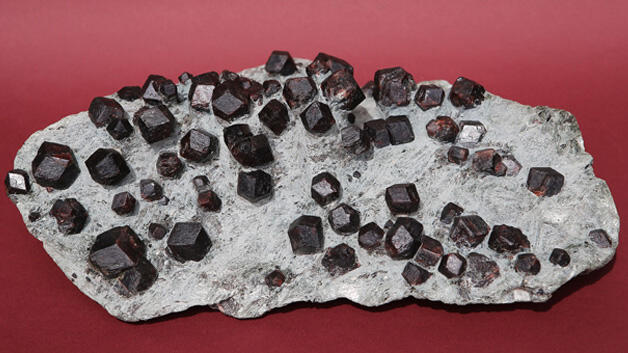Projects
Heritage Science Austria Call:
Garnet from the Ziller Valley – Cultural heritage of an East Alpine semi-precious stone industry as reflected in interdisciplinary research
Funding program of the ÖAW:
Heritage Science Austria Call, Project number: Heritage_2020‐094_GAZIVA
The project is funded by the Heritage Science Austria grant program of the Austrian Academy of Sciences.

Other funding sources:
Office of the Vice Rector for Research

Duration:
01.06.2021-31.05.2025
Principal Investigators
Gert Goldenberg (Coordinator), Institute for Archaeology, University of Innsbruck
Peter Tropper, Institute for Mineralogy and Petrography, University of Innsbruck
Gunda Barth-Scalmani, Institute for Historical Sciences and European Ethnology, University of Innsbruck
Gertraud Zeindl, Tyrolean Provincial Archives, Innsbruck
Katharina Weiskopf, High Mountain Nature Park Zillertal Alps, Ginzling
Project staff (PhD students):
Bianca Zerobin, Institute for Archaeology, University of Innsbruck
Roland Köchl, Institute for Historical Sciences and European Ethnology, University of Innsbruck
Simon Wagner, Institute for Mineralogy and Petrography, University of Innsbruck
Citizen participation:
Walter Ungerank (Chronist, Aschau)
Josef Hofer (Family history, Zell a. Z.)
Josef Brindlinger Sen. and Jun. (Family history, Zell a. Z.)
Introduction

In the high-altitude areas of the inner Ziller Valley in Tyrol, garnet was mined as semi-precious stone from the late 18th to the early 20th century and processed into rough stones for gemstone trading. Two families were involved in the extraction of the mineral from garnet-bearing micashists and its far-reaching trade throughout Europe. The garnets from the Ziller Valley, together with garnets from the Ahrntal in South Tyrol and Radenthein in Carinthia, were delivered first and foremost to the centres of gemstone cutters in Bohemia where the finishing to cut and polished gemstones and garnet jewellery took place.
Numerous remnants of the former garnet-processing infrastructure have been preserved in the high altitudes of the inner Ziller Valley close to the garnet deposits and thus form a unique cultural heritage in the heart of the “High Alps Nature Park Zillertaler Alps”. This heritage includes ruins of crushing and sorting huts and garnet mills, as well as an elaborate network of footpaths. Private collections of a large number of physical objects like garnet specimens, tools and remaining stocks of merchandise from the last exploitation period are in the possession of a well-known mineral collector and of the descendants of the garnet traders. These collections also include large volumes of handwritten documents and are available in their entirety for interdisciplinary studies. The aim of these studies is to reconstruct the social and economic history of this forgotten small-scale industry of the late 18th to early 20th century and the far-reaching trade networks in the territory of the former Habsburg monarchy.
Within the framework of the project, the cultural heritage of this unique historical semi-precious stone industry in the Eastern Alps will be investigated from different perspectives and then prepared for museum presentation. The focus is on the archaeological investigation of the physical legacies, the study and archival storage of the written sources and the mineralogical/geochemical characterisation of the semi-precious garnet from the Ziller Valley.
Garnet from the Ziller Valley – geology and mineralogy
In the western part of the “Tauern Window” (Penninic, crystalline complex in the eastern Alps) garnet-bearing metamorphic micaschists occur in the area of the inner Ziller Valley and the Tux Alps (Greiner series). The garnet here is represented mainly by the iron-rich variety almandine, Fe3Al2(SiO4)3. Among mineral collectors the dark red almandine with its distinct crystal faces is a coveted and highly sought after mineral and attractive for collections and exhibitions. Since the 18th century, garnet of high quality from the inner Ziller Valley was mined and marketed as a semi-precious stone and thus provided the basis for a small-scale industry/folk industry in the Eastern Alps, which secured an income for the local garnet miners as well as for entrepreneurs and merchants.


Garnet occurrences at the “Rossrücken” in the Zemmgrund


In the 18th, 19th and early 20th century a centre of garnet mining in the inner Ziller Valley was located in the valley called Zemmgrund. Here the garnet occurrences at the Rossrücken were intensively exploited up to 2,800 meters above sea level. The rugged north-facing rocky ridge of the Rossrücken is flanked by the glacier valleys of the Waxeggkees to the west and the Hornkees to the east. While today the ice of these two glaciers retreated very far in the 1850’ ("little ice age") the Rossrücken was completely enclosed by both glaciers. Access to the garnet occurrences during this period was only possible over the ice, snowfields and boulder fields. Some of the huts and workshops of the garnet workers were located in the immediate vicinity of the glacier margin.
“Garnet pickers” at the Rossrücken - life and work under extreme conditions
Ludwig von Hörmann (1877), among others, reports on the life of the garnet workers ("Granatenklauber", "Granatler") in the extreme high alpine landscape in a contribution to the history of customs and small-scale industries in the Alps. In conjunction with vivid wood engravings by Richard Püttner (1872) and Georg Arnould (1878), which depict the garnet huts and the everyday work and tools in great detail, these descriptions provide deep insights into the working and living conditions of the “garnet pickers". They spent the summer months in the high mountains in simple huts, slept on hay and kept goats for milk. Although they had to work hard with very low incomes under sometimes harsh weather conditions and thus were exposed to great dangers, they were described as silent content and cosy people - and with furrowed faces tanned by the high-altitude sun.


Archaeological features in the Zemmgrund
In the Zemmgrund, numerous ruins and remains from the time of garnet mining can still be observed in the field today. In their entirety these remains represent a unique cultural heritage in the heart of the High Alps Nature Park Zillertaler Alps. This includes mining sites as well as the ruins of garnet huts (crushing and picking huts) near the garnet occurrences at high altitude. Spectacular are also the partially preserved historic alpine paths passing through imposing boulder fields that used to lead to the remote garnet huts. Further down, at the foot of the Rossrücken are the badly decayed ruins of a former water-powered garnet mill/garnet tamp, where the garnets were separated from the micaschists. In wooden drum boxes the garnets were further processed until only the highest quality pieces remained, which were then transported as "tumbled garnets” down to the main valley and marketed and traded from Zell am Ziller.


The garnet business - the Kreidl and Hofer families

In 1747, Andrä Kreidl from Mayrhofen in the Ziller Valley, received the first permit for mining garnet at the Rossrücken in the Zemmgrund. At the beginning garnet was solely mined and sold for the production of flint stones. Later, the much more profitable marketing of garnet as a semi-precious stone for jewellery began. While at first a gemstone-cutting factory in Salzburg was supplied with the garnet, the “international” business began around 1805 with the official permission to export the garnets. From then on, gemstone cutters in Bohemia were the most important customers. In 1837 Josef Hofer also began mining and trading garnets in the Ziller Valley, but due to the already extensive mining rights of the Kreidl family in this area he focused his activities on garnet occurrences in the Ahrntal in South Tyrol and in the Nock-Mountains near Radenthein in Carinthia. The trading office of the Hofer family as well as workshops for processing the garnet into merchandise were also located in Zell am Ziller. Both families continued the garnet trade until the beginning of the 20th century.



Gemstone cutters in Bohemia and in the Black Forest

At the beginning of the 19th century, gemstone cutters in Bohemia took over the purchase and processing of the garnet from the Ziller Valley (and from Radenthein) into gemstones for the jewellery production. In Bohemia, based on local garnet occurrences of very good quality (Cr-bearing pyrope, Mg3Al2Si3O12), a centre of garnet cutting developed in the 18th century. Since the garnets from the eastern Alps, after being processed into cut gemstones, mostly reached the jewellers and their customers under the trade name of "bohemian garnet", it is difficult today to distinguish garnet from the Ziller Valley in a historical piece of jewellery. Further complications arise due to the fact that during this period there were numerous garnet cutters working in the Black Forest (Waldkirch, Freiburg, Kinzigtal), which also mainly processed "bohemian garnet". From an art historical point of view, the production of garnet jewellery in the 18th, 19th and early 20th century falls into the epochs of Biedermeier, Historism and Art Nouveau.


Consignment note of a shipment of garnets dated 5.12.1868 to the gemstone cutting company “Gebrüder Trenkle in Waldkirch” in the Black Forest (scan: B. Zerobin, original owned by the J. Hofer family)
Collections of garnet from the Ziller Valley
Extensive collections of garnet specimens, as well as objects from the period of garnet mining (tools, implements, remains of merchandise) and handwritten documents from the 19th and early 20th century are in the possession of the well-known mineral collector and local chronicler Walter Ungerank and the descendants of the Hofer and Kreidl families. This material is available for detailed documentation and examination within the framework of this interdisciplinary research project. This business maintained far-reaching trade networks on the territory of the former Habsburg monarchy and thus was able to market its products profitably on the gemstone market. Together with the still preserved archaeological remains in the high mountains, this material tells the exciting story of an Eastern Alpine small-scale industry threatened today with oblivion.


The mineralogical/geochemical analysis of the garnet

One aim of the project “garnet from the Ziller Valley” is to work out characteristic features of the different garnet varieties from the Eastern Alps and from Bohemia with the help of non-destructive analytical methods in order to obtain a tool for their differentiation in historical jewellery. Starting point is the mineralogical/petrological investigation (P-T-X conditions) of the garnet occurrences in the inner Ziller Valley as well as of the residues from the historic garnet processing sites. While the garnet from the metamorphic micaschists of the Ziller Valley is represented by almandine Fe3Al2(SiO4)3, the Bohemian garnet is a chromium-bearing pyrope Mg3Al2(SiO4)3 of magmatic origin. This fundamental difference in its chemical composition allows a distinction at a first glance between Eastern Alpine and Bohemian garnets. With the help of mineralogical-geochemical as well as spectroscopic methods the composition of the garnets from the four different occurrences in the Ziller Valley, in the Ahrntal, in Radenthein and in Bohemia will be determined and extensively characterized. The aim is to search for further significant chemical features which will allow the decisive identification of garnet from the Ziller Valley in a piece of historical jewellery.
Project partner “garnet from the Ziller Valley”
- Institute of Archaeologies, University of Innsbruck & RC HiMAT (Gert Goldenberg, Bianca Zerobin, Gerald Hiebel, Ulrike Töchterle)
- Institute of Mineralogy and Petrography, University of Innsbruck & RC HiMAT (Peter Tropper, Thomas Angerer, Simon Wagner)
- Institute of Historical Sciences and European Ethnology, University of Innsbruck (Gunda Barth-Scalmani, Kurt Scharr, Roland Köchl)
- Tyrolean Provincial Archives Innsbruck (Gertraud Zeindl)
- High Alps Nature Park Zillertaler Alps, Ginzling (Katharina Weiskopf, Willi Seifert)
- Walter Ungerank, Aschau Zillertal (mineral collector and local chronicler)
- Josef Hofer and Josef Brindlinger families, Zell am Ziller (descendants of the garnet traders)
- Descendants of Andrä Kreidl in Zell am Ziller, Innsbruck and Vienna
Cooperation partner
- Peter Asmann, director of the Tyrolean State Museum Ferdinandeum and the Museum of Tyrolean Regional Heritage: access to garnet samples from Tyrolean occurrences and to historic traditional Tyrolean garnet jewellery.
- Thomas Hornung, geologist, Salzburg: geological mapping of the nature park area on behalf of the High Alps Nature Park Zillertaler Alps.
- Peter Pindur, geographer, Brixlegg: glacial development in the Zemmgrund in the Ziller Valley.
- Georg Kandutsch, mineralogist, Granatium Radenthein: mineralogy of the Radenthein garnet occurences.
- Christoph Hauzenberger, petrologist, and Kurt Krenn, geologist, Institute of Earth Sciences, University of Graz: metamorphic rocks in the eastern Alps, study of fluid inclusions.
- Albert Gilg, engineering geologist, Technical University of Munich: mineralogical and geochemical characterisation of ornamental garnets.
- Jaroslav Hyršl, gemmologist, Prague: gemstone analysis, especially garnet (Bohemian garnet and others).
- Radek Hanus, gemmologist, Prague: gemstone analysis, bohemian garnet
- Lucie Kodišová, curator, Czech National Museum, Prague: art history, historical jewellery, gemmology
- Bernd Wintermantel, gemstone cutter, Waldkirch (Black Forest): historical gemstone cutting workshop
- Karl Berger, ethnologist, Folk Art Museum Tyrol, Innsbruck: folklore collections
- Michael Span, Historian, Folk Art Museum Tyrol, Innsbruck: folklore collections
Gampe, T., Böhmische Granaten. Die Gartenlaube 1893, 107-110.
Gilg, H. A., Gast, N. & J. Hyršl, Chromium Pyropes from Bohemia: Characterization and Identification in Archaeological and Historical Jewellery. In: Mineral Resources in a Sustainable World. Proceedings of the 13th Biennial SGA Meeting, 2015, Nancy, France, 1301-1304.
Gilg, H. A., Gast, N. & und Calligaro, T., Vom Karfunkelstein. In: Karfunkelstein und Seide. Neue Schätze aus Bayerns Frühzeit, Ausstellungskatalog München 2010, 87–100.
Gilg, H. A. & J. Hyršl, Garnet mines in Europe. In: J. Toussaint (ed.), Rouges et noirs, rubis, grenat, onyx, obsidienne et autres minéraux rouges et noirs dans l’art et l’archéologie. Société archéologique de Namur 2014, 145-173.
Hörmann, L. v., Die Granatler. In: Der Alpenfreund, Band 4, Gera 1872, 9-15.
Hörmann, L. v., Tiroler Volkstypen. Beiträge zur Geschichte der Sitten und Kleinindustrie in den Alpen, Wien 1877.
Kopka, E., Zur Geologie der Umgebung von Mayrhofen im Zillertal. Mitteilungen der Geologischen Gesellschaft in Wien, 47, 1954, 1-34.
Kouřsimský, J., Das Feuerauge aus böhmischen Vulkanen. In: Granat, die Mineralien der Granat-Gruppe: Edelsteine, Schmuck und Laser. extraLapis 9, 1995, 76-83.
Leute, M. A. & Götzinger, M. A., Einschlusscharakterisierung von Zillertaler Schmuckgranaten, Tirol, Österreich. Mitt. Österr. Miner. Ges. 146, 2001, 175-177.
Metz, R., Edelsteinschleiferei in Freiburg und im Schwarzwald und deren Rohstoffe. Lahr 1961.
Nitzsche, C., Die Gletscher der Zillertaler Alpen … vom nacheiszeitlichen Gletscherhöchststand bis heute. Gletscherstudie des Hochgebirgs-Naturparks Zillertaler Alpen. Ginzling 2015.
Pindur, P. & Heuberger H., Zur holozänen Gletschergeschichte im Zemmgrund in den Zillertaler Alpen, Tirol/Österreich (Ostalpen): Zeitschrift für Gletscherkunde und Glazialgeologie, Band 42/2, 2008, 21-89.
Püttner, R., Bei den Tiroler Granatenklaubern. Die Gartenlaube 1872, Heft 31, 505-507, 510.
Rouse, J. D., Garnet. Butterworths Gem Books, 1986.
Seifert, A.V. & Vrána, S., Bohemian garnet. Bulletin of Geosciences, Vol. 80, No. 2, 2005, 113-124.
Ungerank, W., 250 Jahre Zillertaler Granat. In: Zillertal. Das Tal der Gründe und Kristalle. extraLapis 12, 1997, 12-25.
Ungerank, W., Granat aus den Ost-Alpen. Geschichte, Verarbeitung und Nutzung. In: Stöllner, Th. & Oeggl, K. (eds.), Bergauf – Bergab. 10.000 Jahre Bergbau in den Ostalpen. Bochum 2015, 593-597.
Weise, Ch. (ed.), Granat - Die Mineralien der Granat-Gruppe: Edelsteine, Schmuck und Laser. extraLapis No. 9, München 1995.
Website administration: Lisa Obojes



